Table of contents
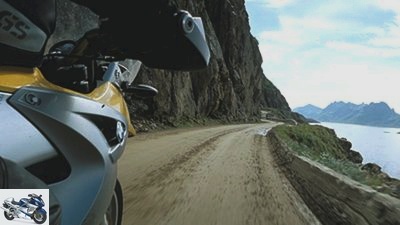
Daams
to travel
Northern Norway
Northern Norway
Lofoten
?? Green Alps in the sea ?? the Norwegians call the Lofoten archipelago protruding from the North Sea. A mandatory detour for everyone who has already left the Arctic Circle behind them.
Klaus H. Daams
05/27/2005
In the afternoon, at the end of June, in the port city of Bodø, 80 kilometers beyond the Arctic Circle. Norwegian west coast. An uncomfortable gray sky, the gloomy cloud mountains build up in front of Frank and me as high and black as the Eiger north face. We should get out of here. Best to go out to the Lofoten, far out in the sea and probably beyond the gray low pressure front that is building up. At 6.30 p.m. the next ferry goes to Moskenes – we will be on board.
Before doing this, simmer a little soup from the well-stocked galley. Open the suitcase, take the stove out, bring the bags and the water bag. Motorcyclists on a Nordland tour are self-sufficient. And hopefully strong stomach. Because if you want to go to the islands off the west coast, you have to be able to cope with rough seas. There, between the islands of Moskenesøy and Mosken, runs the maelstrom, the strongest ocean current in the world. It gets particularly tricky when a stormy wind presses against the incoming tide. Which has already turned into a swirling doom for many a ship. Today, thank God, it’s harmless, and some passengers even take a nap, as if to block out the rocking world.
Buy complete article
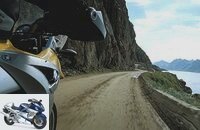
Northern Norway
Lofoten
15 pages) as PDF
€ 2.00
Buy now
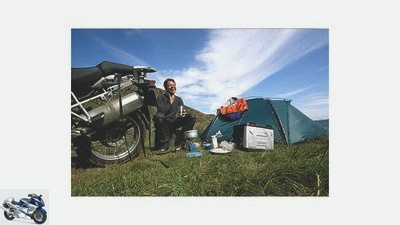
Daams
Thanks to everyone’s right: camp in the most beautiful places.
Bad luck for them, because if you look far ahead over the spraying bow wave, you are blown away. Especially when the gloomy sky finally tears open and the first rays of sun blink through the wispy clouds. What juts out of the sea on the horizon, gets bigger by the minute and looks like a mixture of the main ridge of the Dolomites and part II of “The day after tomorrow”, is our travel destination: The 120 kilometer long Lofoten wall of the southern archipelago, consisting of countless mountainous individual islands.
Around 10 p.m. we dock in Moskenes, a real gem of a church, colorful wooden houses and fishing boats, framed by rock faces like a spanner. Just early enough to cover a few more kilometers on the large BMW enduro bikes R 1200 GS and Kawasaki KLV 1000 to unwind. Because up here, north of the Arctic Circle, the midnight sun ensures brightness around the clock from May 27th to July 17th. The period even extends further north, at the North Cape
from May 13th to July 29th. Who can and wants to think about sleep? When we arrive, however, clouds come in and make the light look a little pale. The low-hanging white pebbles of cloud that cover the mountain ridges from the west like boiling milk soup bring some movement into the ghostly scenery. And then let yourself fall into the next sink in a kind of super slow motion – or, in a miraculous way, withdraw again.
Northern Norway (3)
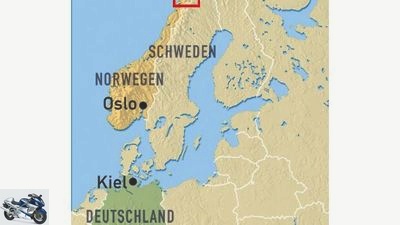
Map: Maucher
The Lofoten are between Bodo and Tromso in front of the Norwegian west coast, in the north there is a bridge to the mainland.
To be on the safe side, we prefer to look for dry accommodation and come across the ocher yellow “Vandrerhjem” in Stamsund. It impresses with civil prices and is “surrounded by natural beauty”, as the brochure aptly proclaims. And this is where Roar lives. One of the 5000 inhabitants who stayed in Lofoten and Vesterålen after the rural exodus in the 80s. Apart from almost three million tourists a year. Roar, the stocky beard and pullover, perhaps a pirate, would have been a Viking even earlier; Today he is the boss of the home and the youth hostel in the Rorbuer style and even has a small room with a sea view for us. top!
We quickly unload and set off again to the island of Gimsøya, where we want to watch the sun not go down near Kleivan. The place is nicely chosen. All around us, meadows strewn with filigree dandelions, rocks jutting out of the water like molehills and the Kleivan lighthouse. The rugged mountain ranges of the neighboring islands form the horizon in the west and east. And above all the light blue sky adorned with a whitish-gray cloud painting, which eludes a precise description due to rapid changes. Everything is stroboscopically flashed by the sun, which, completely unpredictable, throws a few million lux here and there.
Back at the youth hostel, there’s the now familiar midnight soup that should actually be eaten on the terrace with a view of the bay and rocks – if it weren’t for the annoying mosquitos. Does not matter. The fate of the north. The rocks tower in front of us. The legend tells that once the gods Thor smashed it in the North Sea and created the Lofoten Islands. And then he piled up the chunks to get a better view of the schools of fish. No question about it, fish is the main theme on the islands.

Map: Maucher
Time required: three to four days; Route length: 650 kilometers.
In particular, cod, which migrated from the Barents Sea to spawn in the up to 90 kilometers wide Vestjord between January and April, brought fishermen the best catches until the 1950s, before merciless overfishing seemed to mean the end. Only strict catch quotas allowed the stocks and thus the number of employees to grow again. Today, 20 million tons of cod are pulled from the sea, which is up to 400 meters deep, every year by 2000 fishermen. The depth, together with the warm Gulf Stream, is one of the reasons why even whales cavort here.
One last sit-in at Nescafe and muesli on the wooden planks of the youth hostel, and the pistons catapult themselves from one dead center to the next and us into the new day.
Northern Norway (2)
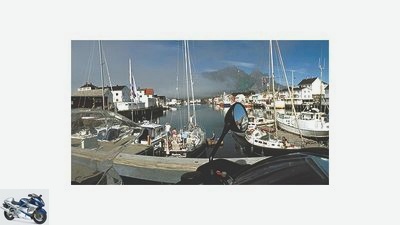
Daams
Fish, fishermen, fishing trawlers: alongside tourism, the number one topic in Lofoten.
We first inspect the southernmost accessible place in Lofoten, which is simply called Å in short. A colony of white mobile homes crouches like a herd of sheep. You are right, we too should start looking for a campsite. The search for a place to sleep in Scandinavia is actually ingeniously simple because of the public rights: Everyone can camp wherever they like. But apparently the many fine spots make us too picky.
Escaping the mainland weather happily, you have to find a box seat for the first night in Lofoten, with a prime view of the sea, the midnight sun and so on. But the later the night, the more modest the demands – and unfortunately the weather too. At some point we are happy when Sakrisøy has at least a passable meadow before it starts to trickle. Slightly sloping, but at least with a view of the fjord.
Buried deep and long enough in the sleeping bag, a rain front can also be laid out – old German camping rule. And indeed. At ten o’clock in the morning the world is all right again. Below us lies the Kirkefjord, as we have since discovered, which is a bit reminiscent of the Konigssee near Berchtesgaden. However, without the Bartholomaus chapel, instead with a fishing cutter and Lofoten high mountains instead of Watzmann. We turn on the stove and soon the aroma of coffee is wafting through the clear air. On the other hand, on the other side of the street, it smells clearly bitter. Long rows of fish heads and bizarrely mummified remains of cod, which are traditionally processed into stockfish in Norway, dry on wooden racks.
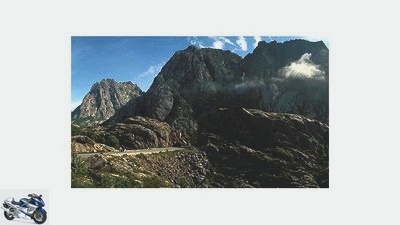
Daams
Imposing from all sides: the so-called Lofoten Wall.
We load up and head north. And end up in the Unesco cultural monument Nusfjord, the Rothenburg ob der Lofoten, so to speak and accordingly surrounded by coaches. Because of the car-free zone, we also have to take a short walk. And come across a nicely decorated village. The highlight: At the small inland harbor there are a few dozen picturesque rorbu, old fishermen’s huts balancing on stilts, which are now rented out as classy holiday apartments. Well, not a case for our stock exchanges, so instead we continue to shimmy across the rugged archipelago.
Separated from the Norwegian mainland by the Vestfjord, the Lofoten (translated means “lynx foot”) together with the north adjoining Vesterålen (“strip in the water”) form a 300-kilometer chain of islands connected by bridges and tunnels. The highest peak is Møysalen, 1266 meters high. The crags rise up steeply and craggy from the sea and therefore have the appearance of the Valais Alps despite their relatively low altitude. There are almost no trees left, they fell victim to the construction of boats and houses. Thanks to the Gulf Stream, the thermometer can climb to over 30 degrees in summer and the water temperature can reach a pleasant 20 degrees on the many beaches. At the moment, however, the temperatures seem far from it, and we are wrapping up in our motorcycle clothes when another shower breaks in.
It is exactly 312 kilometers on the winding island connection road E 10 from Å in the south to Tjeldsund bru at the northern tip, where a bridge keeps the mainland in contact. E not only stands for Europastrabe, but also for extra class, for awe-inspiring, for once is none, Elysian, sublime, excellent. At Valberg on the Vestfjord, we finally turn off and increase the fun for our enduros with an off-road insert. We come across a small herd of sheep that is in “distress” on a tiny sandbank. The animals stand tightly packed on a tiny island surrounded by the sea. Luck for the lawnmowers that they are on the tame southeast side of Lofoten and that the tide is already receding. So they should get away with wet feet.
Northern Norway (info)
Even if the Lofoten only make up a tiny part of Norway, they form an extract of that high-end landscape that is otherwise reserved for the south of the country. And a microcosm of the Norwegian way of life.
General
The Lofoten archipelago and Vesterålen to the north lie between Bodø and Tromsø off the Norwegian west coast. From there, the 300-kilometer chain of islands can be reached in the north by bridge and in the south by various ferry connections. The rugged Lofoten peaks measure only around 1200 meters in altitude, but – rising directly from the sea – appear extremely alpine. In addition to traditional fishing, tourism is playing an increasingly important role. For example, whale safaris are offered in Andenes and excursions to black and white orcas (killer whales) in Kabelvåg and Henningsvær..
Arrival / ferries
The two most popular connections to Norway are from Kiel to Oslo and from Hirtshals in Denmark to Kristiansand in southern Norway. From Oslo to Bodø, where the ferries to Lofoten leave, it’s almost 1400 kilometers. You can find more information about the crossings on our Scandinavia ferry overview on page 136ff. Or directly from Color Line in Kiel, phone 0431/7300300, www.color-line.de and the ferry association & Fahrouristik e.V. (for all of Europe) in Hamburg, phone 040/3601215, www.faehre-vff.de.
Travel time
The best months for motorcyclists are June to August, possibly also September, but some tourist facilities are already closed by then. In May, a number of routes in Norway are often still closed due to snow. Thanks to the warming Gulf Stream, the temperatures in Lofoten can climb up to 30 degrees in summer. Nevertheless, in view of the extreme weather changes in Scandinavia, warm and rainproof equipment should definitely be on board.
motorcycling
While the main roads in Lofoten are paved throughout, many of the access roads to remote places and bays are made of gravel or hard-rolled sandy soil.
Stay
The most independent way of traveling in Norway is with a tent, especially during the midnight sun, which often encourages you to find a place to stay late. You can camp almost anywhere because of the so-called everyone’s right. Alternatives with a fixed roof are the nationwide hytter (wooden huts for two to six people) or – extremely attractive – on the Lofoten the rorbuer, fishermen’s huts converted into holiday apartments. It is cheaper to sleep in a hotel than in Vandrerhjem, the Norwegian version of the youth hostel open to all age groups. There are a total of six such houses in Lofoten and Vesterålen.
Prices
The means of payment is the Norwegian krone. One euro is about eight NOK. A liter of unleaded Eurosuper costs a good ten NOK. Basically nothing is cheap in Norway; it is considered the most expensive country in Europe.
Midnight sun
In summer, north of the Arctic Circle, the sun does not disappear behind the horizon, even at midnight; It stays light day and night. The further north you go, the more days there are on which the sun does not set. In Bodø this time window extends from June 8th to July 8th, in the North Cape from May 13th to July 29th. Downside for the locals: darkness around the clock in winter.
literature
Chapters about Lofoten and Vesterålen can be found in the travel guides “Norway” from Michael Muller Verlag for 21.90 euros and “Southern Norway with Lofoten” from Reise Know-How for 19.90 euros. The focus is on the archipelago in the volumes “Lofoten” from Edition Elch for 18.90 euros and “Lofoten, North Sea Coasts” from DSV-Verlag for 28 euros. Kummerly + Frey recommends sheet 4 »Central Norway« in 1: 400,000 for 11.90 euros plus an overview map for the journey as a road map.
information
Norwegian Tourist Office, Neuer Wall 41, 20354 Hamburg, phone 040 / 229415-18, www.visitnorway.com.
Related articles
-
to travel Norway Norway Northward Just a short ferry crossing from the local North Sea coast, the high alpine southern Norway offers pure motorcycle…
-
Geissler to travel Norway with classic cars Norway with classic cars Troll! Four young people dare to tour Norway on motorcycles that are otherwise…
-
Daams to travel Northern Germany Northern Germany Down the drain… The economic downturn and global structural change have had a massive impact on…
-
Motorcycle tour in Northern Thailand
Jo Deleker 36 pictures Deleker 1/36 Traveling by motorcycle in Northern Thailand. Deleker 2/36 Traveling by motorcycle in Northern Thailand. Deleker 3/36…
-
Norway in midsummer by motorcycle
Lohse 12th pictures Lohse 1/12 With a motorcycle through Norway in midsummer. It burns here for weeks “eternal light”. Lohse 2/12 On the way to Å, the…
-
to travel Norway and Russia Norway and Russia 13,000 kilometers Certainly one could have driven directly from Innsbruck to Moscow in a few days. But if…
-
Motorcycle trip – Norway in summer
Joachim Deleker to travel Motorcycle trip – Norway in summer Motorcycle trip – Norway in summer Weatherproof Norway in summer, time of light, time for a…
-
to travel Northern Portugal Northern Portugal Europe’s last exit If you want to travel to Portugal, you need a lot of patience and a durable tire. Once…
-
Out and about in Northern Portugal
to travel Out and about in Northern Portugal Out and about in Northern Portugal Portugal: true love Love at first sight ?? that can happen quickly in…
-
Out and about in Northern Hesse
Breakable to travel Out and about in Northern Hesse Out and about in Northern Hesse Beyond Kassel The leaves are falling, the last tour of the year: one…